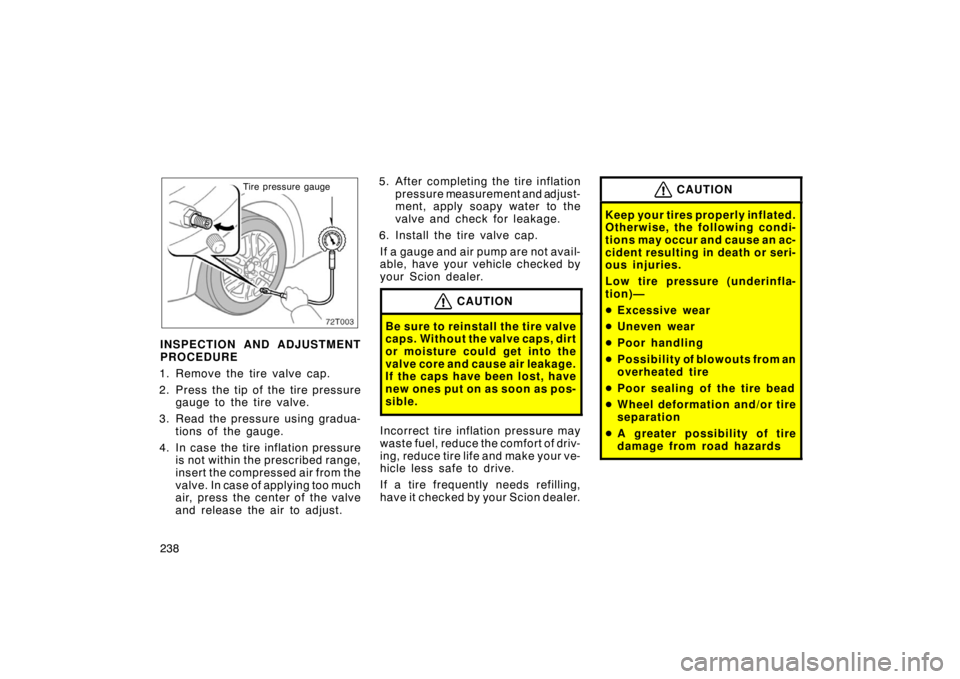Page 234 of 277

226
CAUTION
�When the engine is running, keep
hands, clothing, and tools away
from the moving fan and engine
drive belts. (Removing rings,
watches, and ties is advisable.)
�Right after driving, the engine
compartment—the engine, radiator,
exhaust manifold and spark plug
boots, etc.—will be hot. So be care-
ful not to touch them. Oil, fluids
and spark plugs may also be hot.
�If the engine is hot, do not remove
the radiator cap or loosen the drain
plugs to prevent burning yourself.
�Do not leave anything that may
burn easily, such as paper or rags,
in the engine compartment.
�Do not smoke, cause sparks or al-
low open flames around fuel or the
battery. Their fumes are flammable.
�Be extremely cautious when work-
ing on the battery. It contains poi-
sonous and corrosive sulfuric acid.
�Do not get under your vehicle with
just the body jack supporting it. Al-
ways use automotive jack stands or
other solid supports.
�Be sure that the ignition is off if
you work near the electric cooling
fans or radiator grille. With the
ignition on, the electric cooling fans
will automatically start to run if the
engine coolant temperature is high
and/or the air conditioning is on.
�Use eye protection whenever you
work on or under your vehicle
where you may be exposed to flying
or falling material, fluid spray, etc.
�Used engine oil contains potentially
harmful contaminants which may
cause skin disorders such as in-
flammation or skin cancer, so care
should be taken to avoid prolonged
and repeated contact with it. To re-
move used engine oil from your
skin, wash thoroughly with soap
and water.
�Do not leave used oil within the
reach of children.
�Dispose of used oil and filter only
in a safe and acceptable manner.
Do not dispose of used oil and fil-
ter in household trash, in sewers or
onto the ground. Call your dealer or
a service station for information
concerning recycling or disposal.
�Take care when filling the brake and
clutch fluid reservoirs because
brake fluid can harm your eyes and
damage painted surfaces. If fluid
gets in your eyes, flush your eyes
with clean water immediately. If you
still feel uncomfortable with your
eyes, go to the doctor.
Page 246 of 277

238
Tire pressure gauge
INSPECTION AND ADJUSTMENT
PROCEDURE
1. Remove the tire valve cap.
2. Press the tip of the tire pressure
gauge to the tire valve.
3. Read the pressure using gradua- tions of the gauge.
4. In case the tire inflation pressure
is not within the prescribed range,
insert the compressed air from the
valve. In case of applying too much
air, press the center of the valve
and release the air to adjust. 5. After completing the tire inflation
pressure measurement and adjust-
ment, apply soapy water to the
valve and check for leakage.
6. Install the tire valve cap. If a gauge and air pump are not avail-
able, have your vehicle checked by
your Scion dealer.
CAUTION
Be sure to reinstall the tire valve
caps. Without the valve caps, dirt
or moisture could get into the
valve core and cause air leakage.
If the caps have been lost, have
new ones put on as soon as pos-
sible.
Incorrect tire infl ation pressure may
waste fuel, reduce the comfort of driv-
ing, reduce tire life and make your ve-
hicle less safe to drive.
If a tire frequently needs refilling,
have it checked by your Scion dealer.
CAUTION
Keep your tires properly inflated.
Otherwise, the following condi-
tions may occur and cause an ac-
cident resulting in death or seri-
ous injuries.
Low tire pressure ( underinfla-
tion)—
� Excessive wear
� Uneven wear
� Poor handling
� Possibility of blowouts from an
overheated tire
� Poor sealing of the tire bead
� Wheel deformation and/or tire
separation
� A greater possibility of tire
damage from road hazards
Page 266 of 277
258
Dimensions and weights
Overall length mm (in.):4420 (174.0)
Overall width mm (in.): 1755 (69.1)
Overall height mm (in.): 1415 (55.7)
Wheelbase mm (in.): 2700 (106.3)
Front tread mm (in.): 1505 (59.3)
Rear tread mm (in.):
1505 (59.3)
Vehicle capacity weight
(occupants+cargo) kg (lb.): 392 (865)
Engine
Model:2.4L 4 −cylinder (2AZ −FE)
Type: 4 cylinder in line, 4 cycle, gasoline
Bore and stroke, mm (in.): 88.5 � 96.0 (3.48 � 3.78)
Displacement, cm
3 (cu. in.):
2362 (144.1)
Fuel
Fuel type: Unleaded gasoline, Octane Rating 87 (Re-search Octane Number 91) or higher
Fuel tank capacity, L (gal., Imp.gal.): 55 (14.5, 12.1)